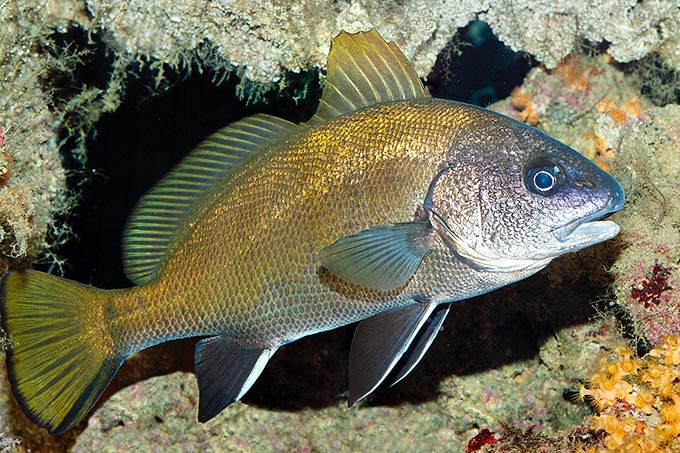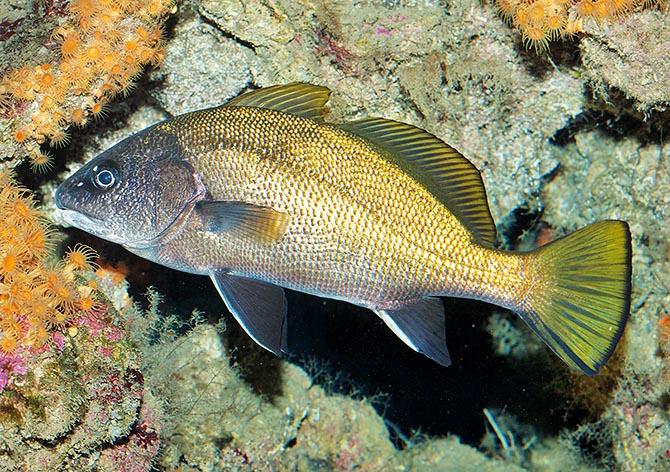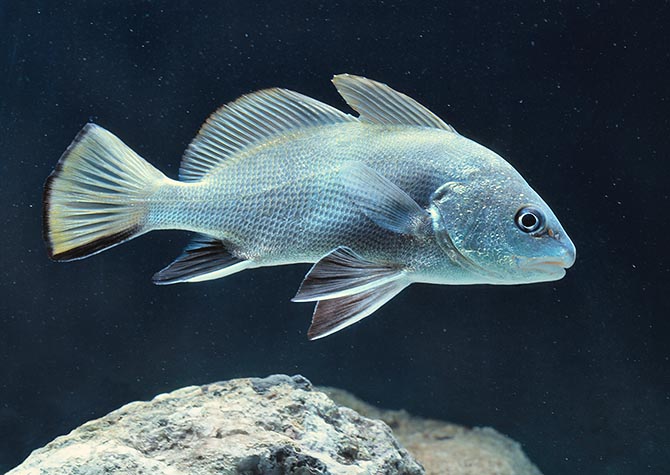Family : Sciaenidae

Text © Giuseppe Mazza

English translation by Mario Beltramini

Brown meagre (Sciaena umbra) lives in shallow waters and loves dark grottoes © Giuseppe Mazza
The genus comes from the Greek “skiaina, skion”, the name they were giving to the fish; the species from the Latin “umbra” = shade, due to the colour similar to a shade.
Zoogeography
The brown meagre is present all over the Mediterranean, Black Sea included, where however the specimens are scarce, as well as on the eastern coasts from Libya to Turkey.
After Gibraltar Strait, we find it, northwards, up to England and, southwards, up to Senegal, including the islands of Madeira, Canaries and Cape Verde.
Ecology-Habitat
It lives in shallow waters, usually between the 8 and the 20 m in summer, going down, at most, up to 200 m during the winter. It is found on the sandy bottoms, especially in the grasslands of Posidonias (Posidonia oceanica), and on the rocky ones.

It can reach the 70 cm but usually does not exceed the 40 cm © Giuseppe Mazza
Morpho-physiology
It can reach the 70 cm, but rarely exceeds, fished, the 40 cm.
Its profile is typical, with the back very curved in comparison to the belly. The mouth, almost horizontal under the roundish snout, has on both jaws 3-4 rows of teeth, to which add, towards the outside, some smaller teeth.
The eye is relatively big and there are two spines, hidden, under the skin of the operculum.
On the contrary, under the chin, the barbel of the Shi drum (Umbrina cirrosa ) its close relative, is absent.
The scales are relatively big and extend also to the pre-operculum and to the operculum. The lateral line follows the gibbosity of the back.
There are two contiguous dorsal fins. The first has 10 spiny rays, the second 1 spiny ray and 23-25 soft. The anal has 2 spiny rays and 7-8 unarmed; the ventral ones, 1 spiny ray and 5 soft; the pectoral are smaller than the ventral and in the adults the caudal is almost square.

Youngs have proportionally bigger fins © Giuseppe Mazza
Ethology-Reproductive Biology
The brown meagre is active mainly during the night, when it goes hunting small fishes and crustaceans, but it seems that, now and then, it integrates its carnivorous diet with some seaweed.
It reaches the sexual maturity when about 25 cm long and reproduces once a year, in summer, with external fecundation.
The lifespan for the juveniles is of 21 years.
The flesh is excellent, but even if this species is endangered by the fishing and that at the Canaries, just to give an example, it nourishes million of tourists per year, we cannot yet say that it is in great danger. In the most favourable conditions, in fact, the populations may double in 1,4-4,4 years. The vulnerability index of this species is of 64 over 100.
Synonyms
Bairdiella umbra Linnaeus, 1758; Coracinus chalcis Pallas, 1814; Corvina canariensis Cuvier, 1830; Corvina umbra Linnaeus, 1758; Johnius umbra Linnaeus, 1758; Sciaena nigra Bloch, 1792.
→ For general information about fishes please click here.
